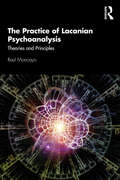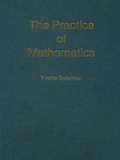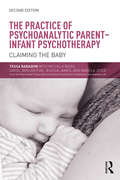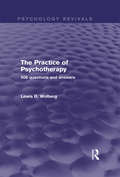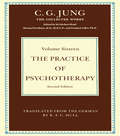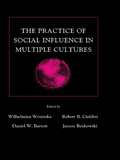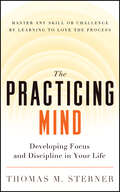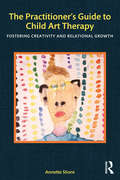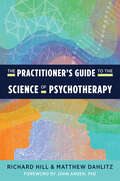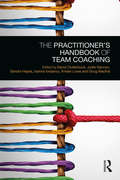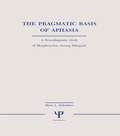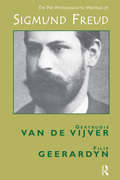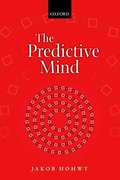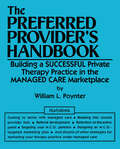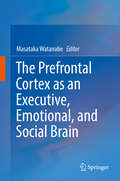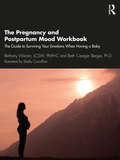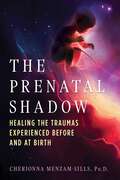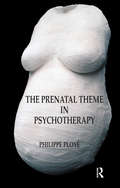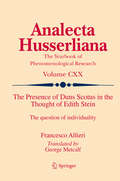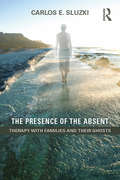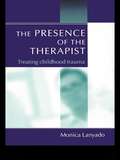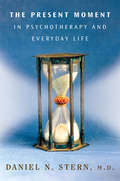- Table View
- List View
The Practice of Lacanian Psychoanalysis: Theories and Principles
by Raul MoncayoThe Practice of Lacanian Psychoanalysis lays out an Aristotelian framework to account for the different types of knowing and not-knowing operative in the theory and practice of psychoanalysis. The book proposes a new model for diagnosis, giving preference to fewer over more diagnoses, and seeks to better organize them by distinguishing between structure and surface symptoms. It examines many principles of Lacanian clinical practice, including different types of frames and evidence, the practice of citation and listening, the resistance and desire of the analyst, transference love as a metaphor, the role of negative transference at the end of analysis, and the identification with the sinthome as Lacan's last formulation regarding the end of analysis. The text also suggests that there are three forms of love and hate based on the works of Lacan and Winnicott. Underpinned by extensive practical knowledge of the clinic and case examples for clinicians, analysts, and practicing Lacanian analysts, this book should be of interest to academics, scholars, and clinicians alike.
The Practice of Mathematics
by Yvette SolomonThe psychological description and explanation of how children learn to work with numbers is dominated by the theories of Piaget. Yvette Solomon suggests an alternative approach to the child's conception of number.
The Practice of Psychoanalytic Parent-Infant Psychotherapy: Claiming the Baby
by Jessica James Angela Joyce Tessa Baradon Michela Biseo Carol BroughtonThe Practice of Psychoanalytic Parent-Infant Psychotherapy is a comprehensive handbook, addressing the provision of therapeutic help for babies and their parents when their attachment relationship is troubled and a risk is posed to the baby's development. Drawing on clinical and research data from neuroscience, attachment and psychoanalysis, the book presents a clinical treatment approach that is up-to-date, flexible and sophisticated, whilst also being clear and easy to understand. The first section: The theory of psychoanalytic parent infant psychotherapy – offers the reader a theoretical framework for understanding the emotional-interactional environment within which infant development takes place. The second section, The therapeutic process, invites the reader into the consulting room to participate in a detailed examination of the relational process in the clinical encounter. The third section, Clinical papers, provides case material to illustrate the unfolding of the therapeutic process. This new edition draws on evidence from contemporary research, with new material on: Embodied communication between parent and infant and clinician-patient/s Fathers and fathering Engagement of at-risk populations Written by a team of experienced clinicians, writers, teachers and researchers in the field of infant development and psychopathology, The Practice of Psychoanalytic Parent-Infant Psychotherapy will be an essential resource for all professionals working with children and their families, including child psychiatrists, psychoanalysts, psychotherapists, and clinical and developmental psychologists.
The Practice of Psychotherapy: 506 Questions and Answers (Psychology Revivals)
by Lewis R. WolbergFreud once humorously remarked that "Anyone who wants to make a living from the treatment of nervous patients must clearly be able to do something to help them". It is amazing how frequently this simple precept is ignored and, when a patient does not get well, how often the failure is attributed to lack of proper motivation, diminutive ego strength, latent schizophrenia, and a multitude of assorted resistances. Difficulties that arise during therapy are not due to a deliberate conspiracy of neglect on the part of the therapist. They usually come about because of obstructive situations that develop in work with patients with which the therapist is unprepared to cope. During his psychiatric career the author, who spent time both teaching and supervising, collected and collated questions from students and graduate therapists who had raised concerns about psychotherapy that related to such obstructive situations. Originally published in 1982, this volume contains both those questions and his answers.
The Practice of Psychotherapy: Second Edition (Collected Works of C. G. Jung)
by C.G. JungThe Practice of Psychotherapy brings together Jung's essays on general questions of analytic therapy and dream analysis. It also contains his profoundly interesting parallel between the transference phenomena and alchemical processes. The transference is illustrated and interpreted by means of a set of symbolic pictures, and the bond between psychotherapist and patient is shown to be a function of the kinship libido. Far from being pathological in its effects, kinship libido has an essential role to play in the work of individuation and in establishing an organic society based on the psychic connection of its members with one another and with their own roots.
The Practice of Social influence in Multiple Cultures (Applied Social Research Series)
by Robert B. Cialdini Daniel W. Barrett Wilhelmina Wosinska Janusz ReykowskiThis book provides a diverse collection of studies reporting the effects of social influence processes in multiple cultures at both the universal and culture-specific levels. The book is characterized by three distinct features. First, the social influence process is considered as a ubiquitous and pervasive feature of human interaction. Second, the book represents a multicultural approach which includes both cross-cultural and culture-focused examinations. Third, the book emphasizes practical implications of the research presented. This volume incorporates theory and research stemming from three different approaches to social influence: social influence principles across cultures, social influence and social change across cultures, and culture and moral perspective in the social influence process. Because each of these three parts encompasses a considerable variety of research methodologies, social contexts, and cultures, each is proceeded by an integrative commentary authored by one of the book editors. These essays provide syntheses of the topics and themes within the corresponding sections and within the book as a whole. They also offer critical commentaries on both theoretical and methodological issues, raise suggestions for future research, and focus on practical applications. This book is intended for both scholars interested in cross- and multicultural research into the mechanisms of the social influence process and for the professional whose mission is to make planned changes in a society. Knowledge about the influence process, especially regarding how it works in different cultures and within several cultural groups, facilitates this goal. The practical implications ending each chapter serve as encouraging instructions for such applications.
The Practicing Mind: Developing Focus and Discipline in Your Life Master Any Skill or Challenge by Learning to Love the Process
by Thomas M. SternerIn those times when we want to acquire a new skill or face a formidable challenge we hope to overcome, what we need most are patience, focus, and discipline, traits that seem elusive or difficult to maintain. In this enticing and practical book, Thomas Sterner demonstrates how to learn skills for any aspect of life, from golfing to business to parenting, by learning to love the process. Early life is all about trial-and-error practice. If we had given up in the face of failure, repetition, and difficulty, we would never have learned to walk or tie our shoes. So why, as adults, do we often give up on a goal when at first we don’t succeed? Modern life’s technological speed, habitual multitasking, and promises of instant gratification don’t help. But in his study of how we learn (prompted by his pursuit of disciplines such as music and golf), Sterner has found that we have also forgotten the principles of practice — the process of picking a goal and applying steady effort to reach it. The methods Sterner teaches show that practice done properly isn’t drudgery on the way to mastery but a fulfilling process in and of itself, one that builds discipline and clarity. By focusing on “process, not product,” you’ll learn to live in each moment, where you’ll find calmness and equanimity. This book will transform a sense of futility around learning something challenging into an attitude of pleasure and willingness.
The Practitioner's Guide to Child Art Therapy: Fostering Creativity and Relational Growth
by Annette ShoreEven in the face of challenging conditions, art therapy treatment offers meaningful opportunities for growth. It’s not always easy, though, to navigate the complex interplay of art processes, relational states, and developmental theories. For any clinician looking for guidance on the ins and outs of using art therapy with children, there is no better resource than The Practitioner’s Guide to Child Art Therapy. Both graduate students and professionals will find its pages replete with strategies for developing engaging and effective tools for understanding children’s creative expression and applying this understanding toward treatment. Clinically relevant and theoretically sound, this book synthesizes the best of the literature on art development, art therapy and child development, while emphasizing the powerful role of art media in fostering creativity and relational growth. Compelling case material and numerous art examples illustrate psychosocial, neurobiological, and attachment theories as well as practical applications, including working with attachment disruptions, anxiety, grief, parental conflict, economic poverty, chemical dependency, child abuse, and autism spectrum disorder.
The Practitioner's Guide to the Science of Psychotherapy
by Richard Hill Matthew DahlitzEstablishing a new, scientifically validated foundation for current psychotherapeutic practice. The twenty-first-century psychotherapist can no longer be constrained by specific schools of practice or limited reservoirs of knowledge. But this new “era of information” needs to be integrated and made manageable for every practitioner. This book helps therapists learn more about this new knowledge and how to apply it effectively. In this single-volume learning resource, Richard Hill and Matthew Dahlitz introduce practitioners to the many elements that create our psychology. From basic neuroscience to body-brain systems and genetic processes, therapists will discover how to become more “response-able” to their clients. Topics include neurobiology, genetics, key therapeutic practices to treat anxiety, depression, trauma and other disorders; memory; mirror neurons and empathy, and more. All are presented with case studies and treatment applications.
The Practitioner’s Handbook of Team Coaching
by David Clutterbuck Ioanna Iordanou Judie Gannon Sandra Hayes Krister Lowe Doug MacKieThe world’s challenges are becoming more and more complex and adapting to those challenges will increasingly come from teams of people innovating together. The Practitioner’s Handbook of Team Coaching provides a dedicated and systematic guide to some of the most fundamental issues concerning the practice of team coaching. It seeks to enhance practice through illustrating and exploring an array of contextual issues and complexities entrenched in it. The aim of the volume is to provide a comprehensive overview of the field and, furthermore, to enhance the understanding and practice of team coaching. To do so, the editorial team presents, synthesizes and integrates relevant theories, research and practices that comprise and undergird team coaching. This book is, therefore, an invaluable specialist tool for team coaches of all levels; from novice to seasoned practitioners. With team coaching assuming an even more prominent place in institutional and organizational contexts nowadays, the book is bound to become an indispensable resource for any coaching training course, as well as a continuing professional development tool. This book is essential reading for anyone with an interest in coaching, in both practice and educational settings. It will be of use not only for professional coaches, but also for leaders, managers, HR professionals, learners and educators, in the business, public, independent and voluntary sectors.
The Pragmatic Basis of Aphasia: A Neurolinguistic Study of Morphosyntax Among Bilinguals (Neuropsychology and Neurolinguistics Series)
by Marc L. SchnitzerThis language study's primary purpose is to use aphasic performance to understand language, rather than to use linguistic analysis to understand aphasia. Examining the detailed nature of linguistic performance of bilingual aphasics in a variety of "natural" and metalinguistic tasks, the book reports the results of a study of morphology and syntax among Spanish-English bilingual and monolingual hispanophones in Puerto Rico.
The Pragmatic Mind: Explorations in the Psychology of Belief
by Mark BauerleinThe Pragmatic Mind is a study of the pragmatism of Emerson, James, and Peirce and its overlooked relevance for the neopragmatism of thinkers like Richard Rorty, Stanley Cavell, Stanley Fish, and Cornel West. Arguing that the "original" pragmatists are too-often cited casually and imprecisely as mere precursors to this contemporary group of American intellectuals, Mark Bauerlein explores the explicit consequences of the earlier group's work for current debates among and around the neopragmatists.Bauerlein extracts from Emerson, James, and Peirce an intellectual focus that can be used to advance the broad social and academic reforms that the new pragmatists hail. He claims that, in an effort to repudiate the phony universalism of much contemporary theory, the new generation of theorists has ignored the fact that its visions of pragmatic action are grounded in this "old" school, not just in a way of doing things but also in a way of thinking about things. In other words, despite its inclination to regard psychological questions as irrelevant, Bauerlein shows that the pragmatic method demands a pragmatic mind--that is, a concept of cognition, judgment, habit, and belief. He shows that, in fact, such a concept of mind does exist, in the work of the "old" pragmatists.
The Pre-Psychoanalytic Writings of Sigmund Freud
by Filip Geerardyn Gertrudis Van de VijverThe traditional dating of the origin of psychoanalysis to 1900, when Freud published The Interpretation of Dreams, ignores the massive body of work he produced well before this date. Covering fields as diverse as neurology, physiology, philosophy, and pharmacology, this wealth of unjustly neglected material was to have a profound influence upon the development of psychoanalytic theory and technique. This fascinating study of the hidden roots of psychoanalysis features contributions from an international panel of authorities on Freud's early writings, and highlights the unparalleled originality of his pre-analytic work. Seeking to restore the openness that originally existed between psychoanalysis and the other sciences, these papers consider Freud's outstanding scientific achievements within neurology and his achievements as a psychologist. Freud's early fascination with cocaine and his substantial monograph on the coca plant are reconsidered in the light of research that places the episode in its historical context. The influence of philosophical writings upon Freud's thought is demonstrated careful consideration of the origins of Freudian concepts in the works of Aristotle, Brentano and John Stuart Mill.
The Predictive Mind
by Jakob HohwyThe Predictive Mind is that the mechanism explains the rich, deep, and multifaceted character of our conscious perception. It also gives a unified account of how perception is sculpted by attention, and how it depends on action. The first part of the book sets out how the theory enables rich, layered perception. The second part uses the simple mechanism in an explanation of problematic cases of how we manage to represent, and sometimes misrepresent, the world in health as well as in mental illness. The third part looks into the mind, and shows how the theory accounts for attention, conscious unity, introspection, self and the privacy of our mental world.
The Preferred Provider's Handbook: Building A Successful Private Therapy Practice In The Managed Care Marketplace
by William L. PoynterFirst published in 1994. Routledge is an imprint of Taylor & Francis, an informa company.
The Prefrontal Cortex as an Executive, Emotional, and Social Brain
by Masataka WatanabeThis book is devoted to the executive, emotional, social, and integrative functions of the prefrontal cortex (PFC). The PFC has usually been studied only with its executive function or with its emotional function, but recent studies indicate that the PFC plays important roles in integrating executive and emotional functions as well as in social behavior. The first part of the book reviews the functional organization of the PFC in human and nonhuman primates. The subsequent part focuses on the integrator of executive and emotional functions. The third part presents the integrator of executive and social functions, and the final part discusses the default mode of brain activities. There are chapters on animal studies, because functional significance of the PFC cannot be described without referring to those studies. Thus many methodologies are presented such as human neuropsychological, neuroimaging, and stimulation studies, and animal neuropsychological, neurophysiological, neurochemical, neuroanatomical, and neuroimaging studies. Bringing those together, this volume provides a timely and concise picture of the function of the PFC. The result is a valuable resource for students and scientists, providing up-to-date information on this emerging research topic.
The Pregnancy and Postpartum Mood Workbook: The Guide to Surviving Your Emotions When Having a Baby
by Bethany Warren Beth Creager BergerThis book helps you throughout your pregnancy and postpartum/postnatal recovery. By helping you understand what you are feeling, and teaching you empirically validated new skills so you can manage your changing moods, you can work toward feeling better. Becoming a new parent is one of the biggest changes one can face in life. You are experiencing enormous changes biologically, hormonally, and emotionally. Your whole life may seem uprooted. It makes sense that you might be feeling significant mood changes as well. With one out of five mothers and one out of ten partners experiencing depression and anxiety when having a baby, this workbook will remind you that you are not alone. This workbook is written with sleep-deprived new parents in mind, providing helpful information in short, digestible segments. These are intermixed with thought-provoking activities such as brief journaling prompts and suggestions for tangible steps to make small, realistic changes. You can pick it up and put it down, reading it on your timing, without the information becoming overwhelming. The workbook covers the entire range of mood symptoms, from the Baby Blues, to anxiety, depression, bipolar disorder, PTSD, OCD, and more. The Pregnancy and Postpartum Mood Workbook uses inclusive language and content applicable to all new parents. There are chapters uniquely dedicated to building attachment, managing awful thoughts, bringing awareness to your partner's mental health, parenting babies in the NICU or with medical issues, and exploring culture, identity, and mental health. There is also a resource section with a wide array of support available to meet the needs of any parent. Adoptive and single parents, LGBTQ+ and heterosexual parents, as well as clinicians and birth workers will find this book to be an invaluable resource.
The Pregnant Male as Myth and Metaphor in Classical Greek Literature
by David D. LeitaoThis book traces the image of the pregnant male in Greek literature as it evolved over the course of the classical period. The image - as deployed in myth and in metaphor - originated as a representation of paternity and, by extension, 'authorship' of ideas, works of art, legislation, and the like. Only later, with its reception in philosophy in the early fourth century, did it also become a way to figure and negotiate the boundary between the sexes. The book considers a number of important moments in the evolution of the image: the masculinist embryological theory of Anaxagoras of Clazomenae and other fifth century pre-Socratics; literary representations of the birth of Dionysus; the origin and functions of pregnancy as a metaphor in tragedy, comedy and works of some Sophists; and finally the redeployment of some of these myths and metaphors in Aristophanes' Assemblywomen and in Plato's Symposium and Theaetetus.
The Prenatal Shadow: Healing the Traumas Experienced before and at Birth
by Cherionna Menzam-Sills• Explains how babies remember their experiences from the womb and birth as implicit memory, impressions that are held in emotions, images, and the body• Examines scientific evidence of how preverbal memory works and how prenates are highly responsive to their mother&’s perceptions• Looks at how to become aware of and acknowledge implicit memory from the womb as well as how to heal and prevent birth traumaIn a world where it is believed that babies lack awareness, somatic pre- and perinatal therapist Cherionna Menzam-Sills, Ph.D., reveals that babies do perceive negative prenatal and birth experiences, which can easily become unconscious shadow, infiltrating the psyche and affecting personality, relationships, behavior, and perceptions throughout life.Drawing on scientific evidence of how preverbal memory works, the author shows how babies, even before birth, are exquisitely sensitive with remarkable potential. She explains how babies remember the intensely formative experiences from this primal period as implicit memory, and she looks at how prenates are deeply influenced by their mother&’s perception of safety or threat, including during labor and birth, which affects their developing nervous systems.Examining the healing and integration of the prenatal shadow, the author presents body awareness exercises, reflection questions, and meditative practices for sensing the little one within and offering them what they need. She also shares stories about how clients were able to express their prenatal emotions, changing their lives with these techniques. By integrating the prenatal and perinatal shadow hidden just beyond conscious awareness, we can heal our relationships with ourselves and our loved ones as well as reconnect with our original potential.
The Prenatal Theme in Psychotherapy
by Philippe PloyeThis book is an attempt to examine whether patients in analysis or therapy can sometimes be said to form a kind of transference that not only operates at a prenatal level but can also lend itself to interpretation just like any other postnatal level of transference.
The Prescriber's Guide: Stahl's Essential Psychopharmacology
by Stephen M. Stahl Meghan M. Grady Nancy MuntnerPrescriber's Guide spin-off covering the most important drugs in use today for treating depression.
The Presence of Duns Scotus in the Thought of Edith Stein
by Francesco AlfieriThis book examines the phenomenological anthropology of Edith Stein. It specifically focuses on the question which Stein addressed in her work Finite and Eternal Being: What is the foundational principle that makes the individual unique and unrepeatable within the human species? Traditional analyses of Edith Stein's writings have tended to frame her views on this issue as being influenced by Aristotle and Thomas Aquinas, while neglecting her interest in the lesser-known figure of Duns Scotus. Yet, as this book shows, with regard to the question of individuality, Stein was critical of Aquinas' approach, finding that of Duns Scotus to be more convincing. In order to get to the heart of Stein's readings of Duns Scotus, this book looks at her published writings and her personal correspondence, in addition to conducting a meticulous analysis of the original codexes on which her sources were based. Written with diligence and flair, the book critically evaluates the authenticity of Stein's sources and shows how the position of Scotus himself evolved. It highlights the originality of Stein's contribution, which was to rediscover the relevance of Mediaeval scholastic thought and reinterpret it in the language of the Phenomenological school founded by Edmund Husserl.
The Presence of the Absent: Therapy with Families and their Ghosts
by Carlos E. SluzkiWhere live our most cherished (or painful) memories? Where do our beloved (or dreaded) exist when departed? In the gray zone between our self and our world, they can exist as internal reminiscences for some and striking images for others; individually or collectively perceived and interacted; vividly or as tenuous presences.This book familiarizes us with six examples of individuals and families in therapy who live and interact with the presence of their absent, pivotal people in their lives who either died or disappeared, but are still there. It familiarizes us with their plight in a tender, compassionate style, describing in detail interviews and therapeutic transformations and, in several cases, follow-ups as well as echoes of those processes. It teaches us to respect those presences as well as how to help families and individuals treasure them…and in many cases to let them go.Written in a vivid, intense language, The Presence of the Absent offers a marvelous insight into these processes that may prove transformative for the therapist (both family and individually-oriented), as well as enlightening to the general public.
The Presence of the Therapist: Treating Childhood Trauma
by Monica LanyadoThe Presence of the Therapist uses clinical studies based on the author's publications over the past 18 years to illustrate work with severely distressed children. The reader is encouraged to enter a dialogue with the author to explore the many dilemmas and difficulties of working with a person who has become highly defensive or fearful as a result of what has happened to them. This book is a highly stimulating account of psychotherapeutic practice. It facilitates careful and broad thought about the therapeutic process and relationship that will improve clinical practice. The practical advice on how to survive in this demanding work will be of great benefit to all psychotherapists.
The Present Moment in Psychotherapy and Everyday Life (Norton Series on Interpersonal Neurobiology)
by Daniel N. SternWhile most psychotherapies agree that therapeutic work in the 'here and now' has the greatest power to bring about change, few if any books have ever addressed the problem of what 'here and now' actually means. Beginning with the claim that we are psychologically alive only in the now, internationally acclaimed child psychiatrist Daniel N. Stern tackles vexing yet fascinating questions such as: what is the nature of 'nowness'? How is 'now' experienced between two people? What do present moments have to do with therapeutic growth and change? Certain moments of shared immediate experience, such as a knowing glance across a dinner table, are paradigmatic of what Stern shows to be the core of human experience, the 3 to 5 seconds he identifies as 'the present moment.' By placing the present moment at the center of psychotherapy, Stern alters our ideas about how therapeutic change occurs, and about what is significant in therapy. As much a meditation on the problems of memory and experience as it is a call to appreciate every moment of experience, The Present Moment is a must-read for all who are interested in the latest thinking about human experience.
